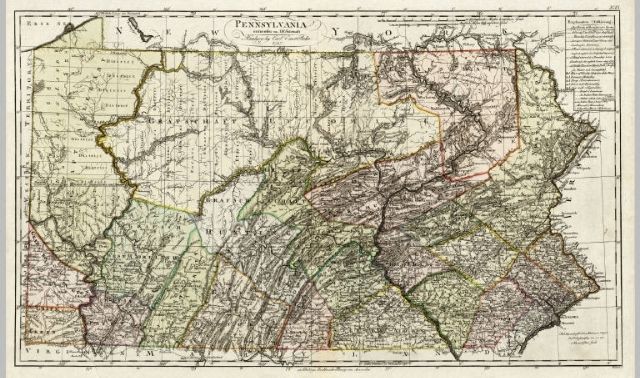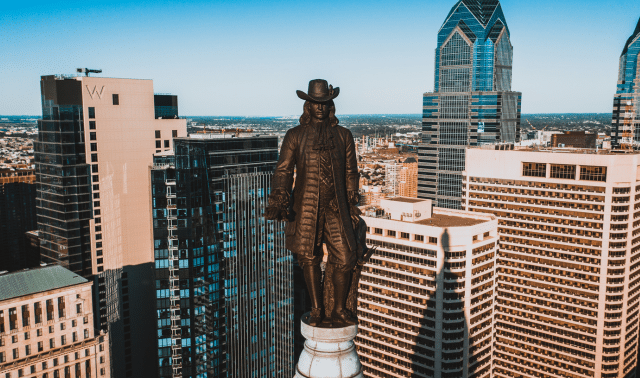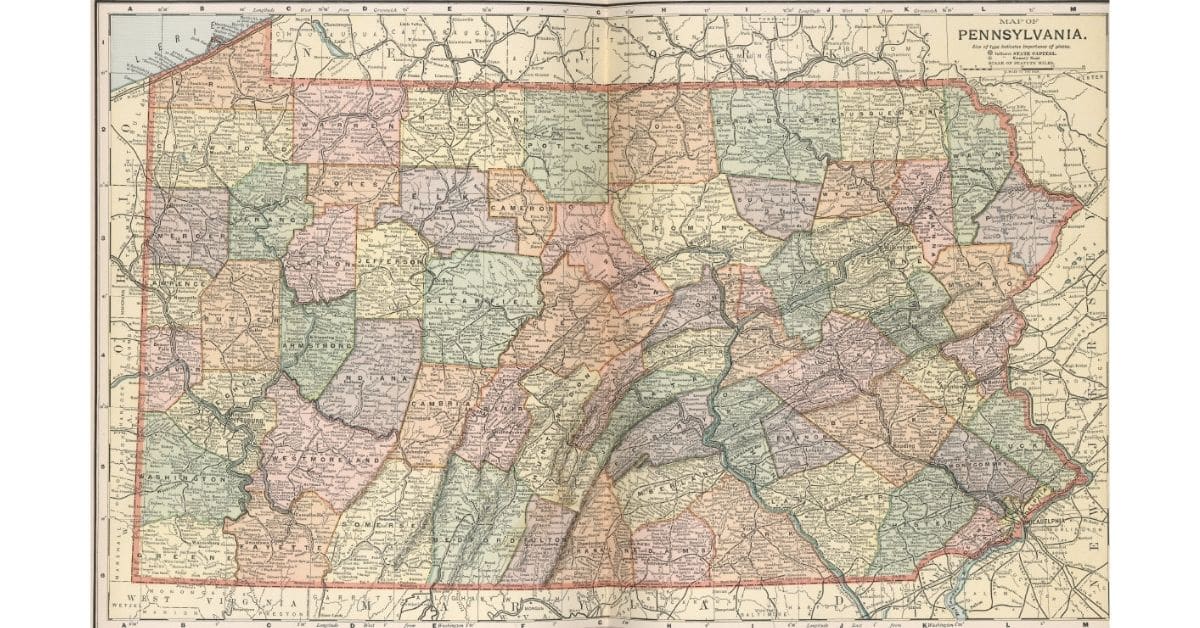The Steel City. The City of Bridges. The City of Champions. In the past 250 years, Pittsburgh’s many monikers have reflected its industrial and manufacturing heritage, geography, and domination in professional sports. Although once described as “Hell with the lid taken off,” Pittsburgh has become the poster child for reinvention. It’s transforming its steel industry roots into a 21st-century economy, and twice has earned the title of America’s Most Livable City from Rand McNally. Genealogically speaking, Pittsburgh is tops, too—thanks to its pre-Revolutionary origins, diverse immigrant ancestry and rich social history. Follow our guide for an abundance of resources to help you forge ahead with your family history research.
- Vital records: In Pennsylvania, statewide registration of births and deaths began in 1906, and birth and death certificates dated that year and later can be obtained from the Pennsylvania Department of Health, Division of Vital Records. Access to birth records is more tightly restricted than access to death records (see the website for details).
Most of the Pennsylvania Archives collection, which includes marriage records along with military, tax, and land records, and other documents from 1664 to 1780, is accessible free at Fold3.com. The Pennsylvania Department of the Carnegie Library of Pittsburgh holds birth records from 1852 to 1854. The Registrar of Wills has birth records for 1893 to 1905.
All Pennsylvania counties began recording marriage licenses in 1885. The index for marriage applications is available in the Office of Wills/Orphans’ Court Division, Marriage Office. Some early marriage records for the city of Pittsburgh only (1870 to 1879) are also available. In addition, the Carnegie Library has an index to newspaper marriage notices from 1786 to 1910, Pennsylvania marriage records from 1852 to 1854 and an Allegheny County Marriage Index for 1885 to 1925.
- Church records: Check with the church your ancestor attended for records. If your ancestor was Roman Catholic, you can request a lookup from the Diocese of Pittsburgh Archives and Records Center for a fee. Records more than 100 years old are unrestricted; newer records have some restrictions. The Smeltzer Bell Research Center at Allegheny College’s Pelletier Library holds Methodist records. Presbyterian records available for research at the Pittsburgh Presbytery include session minutes of congregations.
Founded in 1847, Rodef Shalom in the Shadyside neighborhood is the oldest Jewish congregation in Western Pennsylvania, and its archive is open to the public by appointment. The Rauh Jewish Archives at the Heinz History Center are also worth examining. Pittsburgh’s Jewish Criterion (1895 to 1962), American Jewish Outlook (1934 to 1962) and Jewish Chronicle (1962 to the present) are digitized and searchable at the Pittsburgh Jewish Newspaper Project.
- Census records: In addition to the decennial federal censuses that began in 1790, you can look for ancestors in agricultural, mortality and industrial schedules for Pennsylvania for the 1850 through 1880 censuses. Pennsylvania didn’t take any state censuses, but tax lists, also known as the Septennial Census, were kept from 1779 to 1863. You can find a transcription of Allegheny County’s 1800 tax list and other reference materials at freepages.genealogy.rootsweb.ancestry.com/~njm1.
- Historic Pittsburgh, an online collection from the Historical Society of Western Pennsylvania and the University of Pittsburgh, has plat maps for the greater Pittsburgh area as well as indexes for census entries for Pittsburgh (1850 to 1880) and Allegheny City (1850 to 1870), which was annexed in 1907.
- Land records: Property records are available from 1789, when Allegheny County was formed. Deed index books are located in the Department of Real Estate in the county office building. The two sets of index books list deeds by the grantor (seller) or grantee (purchaser). The Pennsylvania State Archives has land patents as early as 1684.
- Military records: Soldiers and Sailors Memorial Hall, which opened in 1910, is a repository of records relating to Civil War service members from Western Pennsylvania. Among the highlights of its collection are Grand Army of the Republic post records, Army enlistments and Allegheny County burial records for veterans.
- Naturalizations: Naturalization petitions from 1820 to 1930 for the Western District of Pennsylvania are searchable on Fold3.com. Offline, the Western Pennsylvania Genealogical Society has copied Allegheny County naturalizations and published them in a series of books, available in Carnegie Library’s Pennsylvania Department. Obtain copies of the original petitions by contacting the appropriate court. See www.alleghenycounty.us/wo/natural.aspx for details.
- Newspapers: The Carnegie Library has obituaries from many Pittsburgh newspapers. Those from 1786 to 1913 and 1963 to present are indexed; request a lookup for $10. From 1914 to 1962, there is no index, so you’ll need to know the death date. Find other historic newspapers at the University of Pittsburgh’s Hillman Library. The Google News Archive also has digitized certain years of the several Pittsburgh papers including the Press and the Post-Gazette.
Tip: Pittsburgh-area residents have their own distinctive English dialect called Pittsburghese. Learn how to speak like a Pittsburgher at www.pittsburghese.com.
Fast Facts
- Settled: 1758
- Incorporated: 1816
- Nicknames: Steel City, City at the Point, City of Champions
- State: Pennsylvania
- County: Allegheny
- Area: 56 square miles
- Motto: Benigno Numine (Latin for “By the favor of heaven”)
- Primary historical ethnic groups: Scotch-Irish, German, English, French Huguenot, Swiss, Slovak, Polish, Italian, Jewish, Russian, Greek, African-American
- Primary historical industries: steel, coal, iron, glass, Heinz foods, medicine
- Famous residents: Christina Aguilera, Nellie Bly, Jeff Goldblum, Henry J. Heinz, Shirley Jones, Gene Kelly, Arnold Palmer, Art Rooney, Fred Rogers, Jonas Salk, Thomas Starzl, Gertrude Stein, Johnny Unitas, Andy Warhol, George Westinghouse, August Wilson
- Population: 1850–46,601; 1950–676,806; Current–305,704
Timeline
- 1753 George Washington crosses the Allegheny River
- 1758 Pittsburgh named in honor of British statesman William Pitt
- 1787 Pittsburgh Academy, later the University of Pittsburgh, incorporated
- 1826 “Oh! Susanna” composer Stephen Collins Foster born in Lawrenceville
- 1844 Allegheny Cemetery opens
- 1862 Explosion kills 79 at the Allegheny Arsenal
- 1875 Andrew Carnegie opens his first steel plant in Braddock
- 1892 Seven steelworkers and three guards die in Homestead Steel Strike
- 1895 Carnegie Library of Pittsburgh is dedicated
- 1960 Pirates win the World Series against the New York Yankees
- 1968 Mister Rogers’ Neighborhood debuts on Pittsburgh’s WQED-TV
- 1972 Pittsburgh Pirates’ Roberto Clemente dies in plane crash
- 1989-1990 August Wilson wins back-to-back Pulitzer Prizes for drama
- 2009 Steelers win their sixth NFL Super Bowl title
Toolkit
- Allegheny County PA GenWeb Project
- Allegheny County Resources for Genealogical Research
- Archives Records Information Access System
- Coroner Case File Documentation Wiki
- Darlington Digital Library
- Genealogical Society of Southwestern Pennsylvania
- Historic Pittsburgh
- Westmoreland County E-Services Public Records Access
- Guide to Genealogical Sources at the Pennsylvania State Archives by Robert Dructor (Pennsylvania Historical and Museum Commission)
- Pennsylvania Research: County and Township Records by John T. Humphrey (Pennsylvania Genealogy Books)
- Pittsburgh’s Immigrants by Lisa A. Alzo (Arcadia Publishing)
- Pittsburgh: The Story of an American City, fifth edition by Stefan Lorant (Derrydale Press)
- Research in Pennsylvania by Kay Haviland Freilich (National Genealogical Society)
Organizations and Archives
- Archives Service Center, University of Pittsburgh, 7500 Thomas Blvd., Pittsburgh, PA 15208, (412) 244-7091
- Carnegie Library of Pittsburgh’s Pennsylvania Department, 4400 Forbes Ave., Pittsburgh, PA 15213, (412) 622-3154
- City of Pittsburgh Government, Fifth Floor, 414 Grant St., Pittsburgh, PA 15219, (412) 255-2626
- Department of Court Records: Wills/Orphans’ Court Division, First Floor, 414 Grant St., Pittsburgh, PA 15219, (412) 350-4180
- Historical Society of Pennsylvania, 1300 Locust St., Philadelphia, PA 19107, (215) 732-6200
- Historical Society of Western Pennsylvania, Senator John Heinz History Center, 1212 Smallman St., Pittsburgh, PA 15222, (412) 454-6364
- Pennsylvania Department of Health, Division of Vital Records, Box 1528, New Castle, PA 16101, (724) 656-3100
- Pennsylvania State Archives, 350 North St., Harrisburg, PA 17120, (717) 783-3281
- Soldiers & Sailors Memorial Hall & Museum, 4141 Fifth Ave., Pittsburgh, PA 15213, (412) 621-4253
- Western Pennsylvania Genealogical Society, 4400 Forbes Ave., Pittsburgh, PA 15213, (412) 687-6811
Records at a Glance
- Begin: 1906
- Privacy restrictions: Immediate family members may request the birth record of a deceased person, but all other family members must provide a death certificate to gain access to the person’s birth certificate.
- Research tips: Birth records and death records prior to 1906 may be incomplete. Request death records for 1906 to present by mail from the Pennsylvania Department of Health for $10; download the application form at www.portal.state.pa.us/portal/server.pt/community/genealogy_requests/14125. Birth records 1870 to 1905 are at the Carnegie Library’s Pennsylvania Department.
City directories
- Begin: 1815
- Research tips: The Pennsylvania Department, Carnegie Library of Pittsburgh has an extensive collection of city directories (1813 to 1975) and telephone books (1880 to 2002). You can also search 125 directories published between 1815 and 1945 online at Historic Pittsburgh. Find additional directories on subscription site Fold3.com.
Coroner’s records
- Begin: 1887 for Allegheny County
- Research tips: Available from the University of Pittsburgh’s Archives Services Center for $12. Download request form at www.library.pitt.edu/libraries/archives/archives.html. Records from 1933 to June 1938 are missing.
Death records
- Begin: 1906
- Privacy restrictions: All Pennsylvania death records from 1906 to the present are available to direct relatives from the state of Pennsylvania.Research tips: Request death records for 1906 on by mail from the Pennsylvania Department of Health for $9. Download request form at www.portal.state.pa.us/portal/server.pt/community/genealogy_requests/14125. Submit a photocopy of your driver’s license. Death records from 1870 to 1905 are at the Carnegie Library’s Pennsylvania Department.
- Begin: 1885
- Research tips: The index for marriage applications is available in the Office of Wills/Orphans’ Court Division, Marriage Office. Some early marriage records for the city of Pittsburgh only (1870 to 1879) are also available. Divorce records can be ordered from the Civil/Family Court Division.
Top 5 Historic Sites
- Carnegie Museums of Pittsburgh, Carnegie Museum of Art and Carnegie Museum of Natural History, 4400 Forbes Ave., Pittsburgh, PA 15213, (412) 622-3131. Founded by industrialist Andrew Carnegie over 116 years ago, today’s Carnegie Museums are a collection of four dynamic centers of exploration. Besides the museums of art and natural history in the Oakland neighborhood, they include the Carnegie Science Center and the Andy Warhol Museum on the North Shore.
- Fort Pitt Museum and Blockhouse, 101 Commonwealth Place, Pittsburgh, PA 15222, (412) 454-6000. The Fort Pitt Museum, located in Point State Park in downtown Pittsburgh, is a two-floor, 12,000-square-foot museum that tells the story of Western Pennsylvania’s pivotal roles during the French and Indian War and the American Revolution.
- Rivers of Steel National Heritage Area, The Bost Building, 623 E. Eighth Ave., Homestead, PA 15120, (412) 464-4020. The displays at this former hotel and union headquarters are dedicated to chronicling Big Steel and its related industries. Enjoy perusing exhibits at the museum, view the site of the Homestead Steel Strike of 1892, sign up for a formal Carrie Furnace or Babushkas and Hard Hats tour, or download a variety of self-guided cell phone tours from the website.
- Senator John Heinz History Center, 1212 Smallman St., Pittsburgh, PA 15222, (412) 454-6000. An affiliate of the Smithsonian institution, Pennsylvania’s largest museum is devoted to the history and heritage of Western Pennsylvania. Visitors can explore six floors of exhibitions and a research library with materials pertaining to Pittsburgh history, families and companies.
- The Nationality Rooms at the Cathedral of Learning, Fifth Avenue and Bigelow Boulevard, Pittsburgh, PA 15260, (412) 624-6000. This collection of 27 unique classrooms in the University of Pittsburgh’s Cathedral of Learning depicts the ethnic groups that helped build the city of Pittsburgh.
From the December 2011 issue of Family Tree Magazine
More great genealogy resources from Family Tree Magazine:




